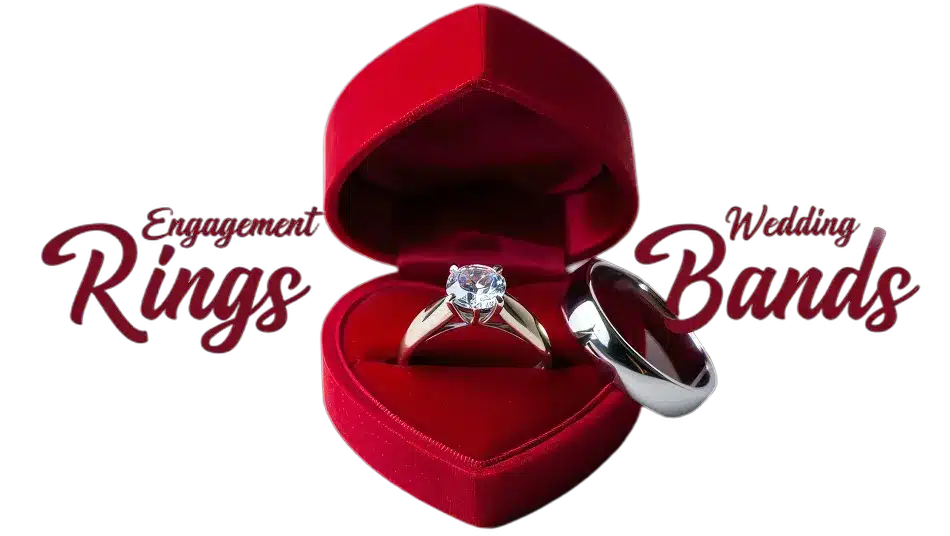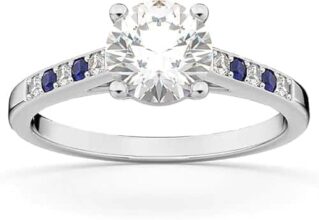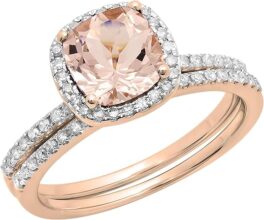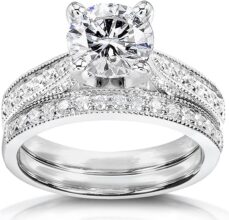
Understanding the Sparkle: An Introduction to Diamond Clarity
When it comes to choosing the perfect engagement ring, diamond clarity plays a pivotal role in your decision-making process. You want a ring that not only represents your love but also captivates the eye. In this article, you’ll discover why diamond clarity is crucial for your engagement ring selection.
We’ll guide you through the essentials of clarity and how it affects the beauty and value of your ring. From understanding the 4Cs of Diamonds to exploring how clarity influences appearance, we’ll help you navigate your choices confidently. Plus, you’ll learn how to select the right clarity for your budget and uncover common misconceptions that might lead you astray. With our expert tips for shopping, you’ll be equipped to find a diamond that reflects your unique love story beautifully. Get ready to master the art of diamond clarity!




What is Diamond Clarity?
When you think about diamonds, clarity is one of the first qualities that often comes to mind. But what does clarity really mean? In the world of gemology, diamond clarity refers to the presence of natural imperfections in a diamond, known as inclusions and blemishes. These tiny characteristics can range from external marks—like scratches or chips—to internal flaws such as air bubbles or mineral inclusions.
Measuring Clarity
Clarity is assessed using a scale developed by the Gemological Institute of America (GIA) and other reputable grading systems. The scale ranges from Flawless (FL), which indicates no inclusions or blemishes visible under 10x magnification, to Included (I), which denotes significant imperfections that can be seen with the naked eye. Here’s a quick breakdown of the GIA clarity scale:
The Significance of Clarity
Why does clarity matter? Beyond its impact on the diamond’s visual appeal, clarity significantly influences its value. A diamond with fewer inclusions typically shines brighter and is perceived as more desirable. Think about it: a diamond might have a magical sparkle, but if it’s marred by noticeable imperfections, its brilliance can diminish.
For your engagement ring, clarity can be more than just a grading—it’s about how the ring makes you feel. Many people love the idea of finding a diamond that feels unique, almost like it has a story of its own.
As you start to explore the various clarity options, it’s essential to consider how these grades will affect both aesthetic appeal and budget. In the next section, we will delve deeper into the 4Cs of Diamonds, with a special focus on clarity and how it intertwines with the other crucial characteristics of a diamond.
The 4Cs of Diamonds: Clarity Explained
When you’re on the quest for the perfect engagement ring, understanding the 4Cs of Diamonds—Cut, Color, Clarity, and Carat Weight—is essential, particularly when it comes to clarity. Each of these characteristics plays a crucial role in the diamond’s overall beauty and value, and clarity often holds the key to a diamond’s lasting impression.
What Are the 4Cs?
Let’s break them down:
Clarity: The Connecting Factor
Understanding how clarity meshes with the other Cs can significantly influence your choice. For example:
Think of clarity as the canvas to your diamond’s portrait. A diamond with better clarity enhances the other characteristics, allowing them to shine.
Choosing Wisely
When narrowing down your choices, reflect on how each C interacts with clarity. A diamond with ideal imperfections—those that remain invisible to the naked eye—might be your best bet for both aesthetics and budget. You might even find a beautiful SI1 clarity diamond that offers an optimal combination of visual appeal and value.
Armed with this knowledge of the 4Cs, you’re now prepared to refine your search. The journey doesn’t stop here; up next, we’ll discuss how clarity affects the appearance of your diamond and help you see how subtle differences can make a world of difference in your selection.
How Clarity Affects the Appearance of Your Diamond
When it comes to the visual appeal of your diamond, clarity serves as a crucial factor. Just like a piece of artwork, the fewer distractions on the surface—meaning inclusions and blemishes—the more captivating the piece becomes. Understanding how clarity affects appearance will empower you to make a more informed choice for your engagement ring.
The Influence of Clarity Grades
Let’s take a closer look at how various clarity grades show their effects in real-life settings:
The Sparkle Factor
Remember that clarity affects how light travels through the stone. Inclusions can interfere with light, leading your diamond to appear less brilliant. Think of it this way: a diamond that shines brightly tells a more compelling story than one with numerous visible flaws.
As you explore rings, keep your eyes peeled for how light interacts with the stone. A diamond’s sparkle is what draws you in, allowing you to appreciate its unique beauty. In the next section, we’ll guide you through budgeting and choosing the right clarity that suits your taste and financial capacity.
Choosing the Right Clarity for Your Budget
When it comes to choosing the clarity of your engagement ring diamond, navigating between quality and affordability is crucial. It’s easy to feel overwhelmed by the many options available, but with a little strategy, you can find a diamond that looks stunning without straining your wallet.
Finding the Sweet Spot
Start by determining which clarity grade suits your aesthetic preferences and budget. Here are some key points to consider:
Real-World Example
Let’s say you’re looking at two diamonds side by side: one VVS1 and one SI1. In a well-lit environment, you might notice that the SI1 diamond catches the light beautifully, while the higher-graded diamond, while technically superior, doesn’t exhibit enough difference to justify the price increase.
Quality vs. Perception
Personal taste plays a critical role in your decision. Many people are drawn to diamonds with lesser clarity grades because they still offer significant beauty while being lighter on the wallet. Trust your instincts—choose a diamond that makes your heart sing, regardless of the grade.
As you contemplate the clarity options, remember that every love story is unique. The right clarity should resonate with both your budget and your vision. Up next, we’ll explore common misconceptions about diamond clarity, ensuring you’re well-informed as you finalize your choice.
Common Misconceptions about Diamond Clarity
When navigating the world of diamond clarity, you’ll encounter several myths that might lead you astray. Let’s debunk some common misconceptions so you can approach your purchase with confidence.
Higher Clarity Always Means a Better Diamond
One of the biggest misconceptions is that a higher clarity grade automatically signifies a better diamond. While clout exists in grades, the overall beauty of a diamond is a delicate balance of all the 4Cs. For instance, a VVS2 diamond may cost significantly more than an SI1, but in a ring setting, the inclusions of an SI1 may be nearly invisible to the naked eye.
This means you could end up with a more visually stunning stone without breaking the bank.
All Inclusions are Bad
Many believe that any inclusion or blemish in a diamond is a dealbreaker. However, inclusions can create character and uniqueness, leading to distinct stones that tell a one-of-a-kind story. Some diamonds are even marketed for their “unique” imperfections! A well-placed inclusion might not detract from beauty but enhance individuality.
Only Size Matters
Another myth is the notion that size trumps clarity and other qualities. It’s easy to assume that a larger carat will overshadow clarity, but a huge diamond filled with visible flaws can often appear less appealing than a smaller, high-clarity stone. In fact, quality can draw the eye much more than mere size.
Clarity Means Visible Inclusions
There’s a persistent belief that the clarity grade directly translates to visible inclusions. In reality, many SI1 and even some SI2 diamonds can look stunning, especially when set in an engagement ring. Often, these diamonds exhibit inclusions that are only detectable under magnification or at certain angles.
Conclusion: Knowledge is Key
Understanding these misconceptions helps bridge the gap between perception and reality. Knowing what really matters allows you to focus on the attributes that enhance your diamond’s overall grace and charm.
Moving forward, we will provide you with tips to navigate the diamond market effectively, ensuring that your engagement ring choice truly reflects your relationship and style.
When you’re ready to shop for an engagement ring, you’ll want to ensure that you’re making an informed choice regarding diamond clarity. Here are some practical, actionable tips to streamline your search and help you find the perfect diamond that suits both your aesthetic desires and budget.
Understand Certification
Before falling in love with any diamond, always check for a reputable grading certificate. This document provides essential details, such as clarity, cut, color, and carat weight. Look for certifications from recognized organizations like the Gemological Institute of America (GIA) or the International Gemological Institute (IGI). These certificates will serve as your diamond’s “birth certificate,” ensuring you’re investing in what you think you are.
Compare Diamonds Effectively
When narrowing down your options, take the time to compare diamonds side by side. Pay close attention to clarity grades under different lighting environments. Bring a loupe (a small magnifying glass) to examine stones closely. Remember, subtle differences can have a big impact on appearance.
- Set Similar Criteria: Compare diamonds within the same clarity grade, color, and cut categories to get an apples-to-apples assessment.
- Consider the Setting: The ring’s design can enhance or downplay the visible inclusions. Try viewing the diamonds in settings you’re considering.
Partner with Reputable Jewelers
Work with jewelers known for their honesty and transparency about diamond quality. Ask questions about the inclusions—this will help you understand how they might impact the diamond’s overall look. A knowledgeable jeweler should guide you towards the best option while keeping your preferences and budget in mind.
Check the Price-to-Value Ratio
Research prices for diamonds of similar quality and characteristics. If a diamond with an SI2 clarity grade sparkles beautifully and falls within your budget, it may be a better option than a higher-graded stone that doesn’t meet your expectations visually.
Trust Your Eyes
Ultimately, the most important judgement lies with you. Trust your instincts and feelings about the diamond’s beauty. Clarity is essential, but so is how the diamond resonates with your personal style. Don’t hesitate to walk away if something doesn’t feel right.
As you weigh your options and clarity choices, consider how the right diamond will mark your love story. With the knowledge you’ve gained, you’re one step closer to selecting a dazzling ring that reflects the bond you share.
Now, let’s wrap things up in our conclusion, where we’ll reflect on making the best choice for your unique love story.
Making Your Choice: The Right Clarity for Your Love
In summary, understanding diamond clarity is essential to finding the perfect engagement ring. By knowing the nuances of the 4Cs and how clarity impacts your diamond’s visual appeal, you can make an informed decision that aligns with both your personal style and budget. Remember, clarity isn’t just a number; it’s about choosing a diamond that speaks to your love story.
So, take your time, explore your options, and trust your instincts. The right clarity will not only enhance the beauty of your ring but will also reflect the unique bond you share. Happy shopping, and may you find the perfect symbol of your love!







